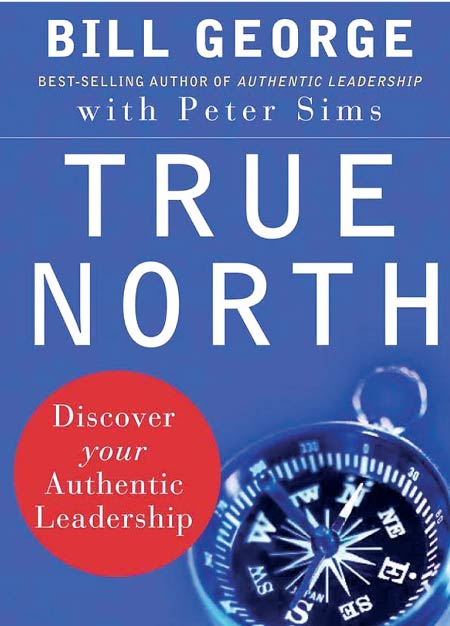Sunday Nov 02, 2025
Sunday Nov 02, 2025
Monday, 4 November 2024 00:15 - - {{hitsCtrl.values.hits}}
 I re-read a book with much interest after so many years. It offers a timely message in highlighting the “True North” and guiding us to discover our authentic leadership. It is also because of Bill George, the author being a “pracademic” with accolades as an authentic leader. Today’s column is a reflection of authentic leadership through the lenses offered by “True North”.
I re-read a book with much interest after so many years. It offers a timely message in highlighting the “True North” and guiding us to discover our authentic leadership. It is also because of Bill George, the author being a “pracademic” with accolades as an authentic leader. Today’s column is a reflection of authentic leadership through the lenses offered by “True North”.
Overview
“True North” is a best-selling book published in 2007, authored by Bill George and Peter Sims. It is a sequel to Bill George’s ground-breaking book on “Authentic Leadership”. The book contains the extracts and the patterns of the interviews Bill George had, wearing the research hat as a Professor of Harvard Business School. His selected sample covered over 125 leaders including then CEOs of Starbucks and Cadbury. Peter Sims, his younger collaborator, is a San Francisco based leadership consultant with exposure in multiple global corporates.
“As the world becomes ever more dangerous and our problems more complex and dire, we long for truly distinguished leaders, men and women who deserve our respect and loyalty.” What George and Sims state at the forward makes much relevance in current turbulent times.
Why “True North”? Our authors elaborate profoundly. “True North is the internal compass that guides you successfully through life. It represents who you are as a human being at your deepest level. It is your orienting point—your fixed point in a spinning world—that helps you stay on track as a leader. Your True North is based on what is most important to you, your most cherished values, your passions and motivations, the sources of satisfaction in your life.” As they further elaborate, “Just as a compass points toward a magnetic pole, one’s True North pulls one toward the purpose of one’s leadership. When one follows his/her internal compass, one’s leadership will be authentic, and people will naturally want to associate with him /her.
“The reality is that no one can be authentic by trying to be like some-one else. There is no doubt you can learn from their experiences, but there is no way you can be successful trying to be like them. People trust you when you are genuine and authentic, not an imitation.” Their advice makes profound sense in current turbulent times.
 Five dimensions of authentic leaders
Five dimensions of authentic leaders
In pursuit of true north with a value-based approach, authentic leaders demonstrate five dimensions in their behaviour. Let us see what they are:
1. Pursuing purpose with passion
“Most people struggle to understand the purpose of their leadership”, observe the authors. In order to find their purpose, authentic leaders must first understand themselves and their passions. In turn, their passions show the way. This was the case with Gandhi in the political sphere, Steve Jobs in the business sphere and St. Mother Theresa of Calcutta in social sphere.
What it highlights is a “purpose driven approach”. One needs to put heart and soul in pursuing it. From a sustainability point of view, an overarching purpose makes the “quadruple bottom line” together with profit, people and planet. Kate Brandt, Google’s Chief Sustainability Officer (CSO), who leads the company’s efforts to achieve net zero emissions and carbon-free energy by 2030, is a current case in point.
2. Practicing solid values
“Leaders are defined by their values, and values are personal—they cannot be determined by anyone else. Integrity, however, is the one value required of every authentic leader.” That’s how Bill George emphasises the need to be value based. Stephen Covey of Seven Habits fame, called the same, “Principle-centred leadership” where authentic leaders never forgo principles for the sake of privileges.
All great religious leaders showed the true value of values. Sony co-founder Akio Morita did not compromise the value of “integrity and sincerity” when he got tempting offers to rebrand Sony with an American name. Howard Behar, the former president demonstrated a core value called “relational leadership” that helped Starbucks thrive. Many such past and present examples provide the proof of long term success of practicing solid values.
3. Leading with heart and head
Authentic leaders lead with their hearts as well as their heads. To some, leading with the heart may sound soft, as though authentic leaders cannot make tough choices involving pain and loss. Leading with the heart is anything but soft. It means having passion for your work, compassion for the people you serve, empathy for the people you work with, and the courage to make difficult decisions. Courage is an especially important quality for leaders as they navigate through unpredictable terrain.” What Bill presents can be summed up with a known phrase, “tough head and a tender heart”.
Jacinda Ardern, the former prime minister of New Zealand shines bright here. Ardern made history as the world’s youngest female head of government when she took office in 2017 at age 37. During her tenure, she led New Zealand through multiple tragedies such as the Christchurch mosque shootings and the COVID-19 pandemic with remarkable effort and empathy.
4. Establishing enduring relationships
The ability to develop enduring relationships is an essential mark of authentic leaders. People today demand personal relationships with their leaders before they will give themselves fully to their jobs. They insist on access to their leaders, knowing that trust and commitment are built on the openness and depth of relationship with their leaders. In return, people will demonstrate great commitment to their work and loyalty to the company.
John Donahoe, a former president of eBay says something insightful. “Leadership is a journey, not a destination; it is a marathon, not a sprint; it is a process, not an outcome.” It invites one to have a conscious shift from a “transactional” approach of getting more work done to a “transformational” approach of empowering people to work more.
5. Demonstrating self-discipline
As Bill observes, “authentic leaders know competing successfully takes a consistently high level of self-discipline in order to produce results”. They set high standards for themselves and expect the same from others. This requires accepting full responsibility for outcomes and holding others accountable for their performance. When leaders fall short, it is equally important to admit their mistakes and initiate immediate corrective action. Self-discipline should be reflected in their personal lives as well, because without personal self-discipline it is not possible to sustain self-discipline at work.
It reminds me of two inter-related Sanskrit terms familiar to us, Shikshanaya (discipline) and Shikshava (education). Interestingly the fifth S of the Japanese productivity technique Five S, also highlights Shitsuke (discipline). Nelson Mandela amply demonstrated self-discipline in his 27 years of stay at the Robben Island Prison. He had an unshakeable vision and values, enormous human warmth, high intelligence and an articulate tongue.
Journey through life
“There is no such thing as the instant leader; your journey to authentic leadership will take you through many peaks and valleys as you encounter the world’s trials, rewards, and seductions” so says Bill George. Becoming an authentic leader takes dedication to one’s development and growth, as there will be many temptations to pull one off the course of True North. Maintaining one’s authenticity along the way may be the greatest challenge one may ever face.
As the book, “True North” further highlights, “the bottom line for all leaders is to optimize their effectiveness to achieve superior long-term results”. Authentic leaders are more effective at doing this because they have a clear sense of their moral compass and are explicitly committed to building their organisations over time. By developing an authentic leadership style, they get the best from their teammates and their organisations.
Among many success stories of authentic leadership, Anne Mulcahy’s one is special. She, using her people management expertise, dramatically turned around $ 18 billion loss-making Xerox in the year 2000. She redefined the motto of Xerox as “world class products and world class services through world class people”.
Even during the difficult phase of cost cutting, the people professionals at Xerox stayed focused on positive employee relations. For example, if laid-off employees were near retirement age, they could add up to a year of unpaid, inactive status to their records so that they could qualify for retirement benefits. The company also continued its yearly employee attitude surveys during the layoff period, which helped the company evaluate whether it was effectively communicating the company’s direction. Anne guided her team to set up various communication programs to emphasise a message of “we really care”.
Way forward
We witness the recent demise of Ratan Tata, an authentic leader by all means. Much has been mentioned about him, with emphasis on his great philanthropic moves. The way he was a true embodiment of the aforesaid five dimensions of authentic leadership is indeed amazing. “Never compromise on your values and principles, even if it’s the hard way”, so said Ratan very often. “Never forget your roots, and always be proud of where you come from”. That’s what he profoundly practiced.
Authentic leaders are in high demand in Sri Lanka. With the general election looming large, will the people of Sri Lanka be wise enough to elect the required leaders with competence and character remains to be seen. The rich insights of the book, “True North” will be valuable for us to determine the direction of our battered nation, with right set of authentic leaders towards prosperity.
(The writer, a Senior Professor in Management, and an Independent Non-executive Director, can be reached at [email protected], [email protected] or www.ajanthadharmasiri.info.)